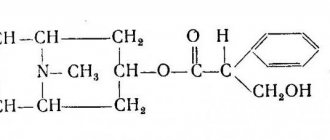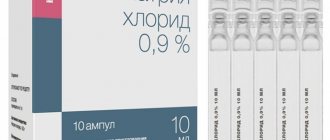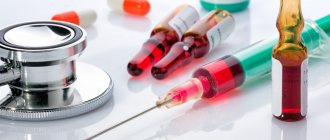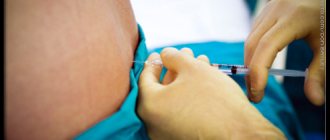Please check with the clinic administrators for availability of vaccines.
Tetanus is a severe acute infectious disease caused by the bacterium Clostridium, primarily affecting the nervous system. Human infection occurs when clostridia penetrate through damaged skin or mucous membranes (wounds, abrasions, cuts, burns with skin damage).
Spores of the causative agent of tetanus can persist for a long time in soil and water. As the disease develops, the most striking symptom is increasing muscle spasms of the limbs and torso (including the respiratory muscles). The disease develops painfully and can lead to complications and, in severe cases, death.
Emergency prevention in cases of likelihood of infection (in case of injury and contamination of the wound, burns, frostbite) consists of treating the wound and administering anti-tetanus serum in a medical facility.
Pharmacodynamics and pharmacokinetics
Pharmacodynamics
Tetanus serum contains immunoglobulins from the blood serum of horses immunized with tetanus toxin . The whey is purified and concentrated by peptic digestion. Specific antibodies neutralize tetanus toxin . The use of antitetanus serum (of varying activity) is indicated for the prevention of tetanus and in the treatment of the disease.
Pharmacokinetics
Data not provided.
Antitetanus serum, instructions for use (Method and dosage)
For emergency prevention of tetanus, antitetanus serum is administered subcutaneously at a dose of 3000 IU. This dose is administered to adults and children as soon as possible after injury and up to 20 days after injury. Before introducing the serum, a test is carried out with diluted serum: intradermally in the forearm in an amount of 0.1 ml and after 20 minutes the reaction is recorded. If the diameter of the redness is less than 1 cm, the test is negative, if 1 cm or more, the test is positive.
If the test is negative, the serum is injected subcutaneously into the outer surface of the shoulder or subscapular region, first in an amount of 0.1 ml, and then the entire dose if there is no reaction. If the test is positive, serum administration is contraindicated. In this case, ICHPS ( human immunoglobulin ) is administered.
When treating tetanus, 10,000–20,000 IU is administered intravenously or into the spinal canal as early as possible. the seizures disappear . The drug can be used to treat tetanus in children from the first days of life. The dosage depends on the condition of the sick child.
Before administering the serum (in any case), antishock therapy is prepared. Given the possibility of shock developing after using the serum, the patient must be monitored for 1-2 hours. Do not use the drug if the integrity of the ampoules is damaged, there is no labeling, or if there is a change in color or transparency.
TESTS
Description
Transparent or slightly opalescent liquid with a yellowish tint, without sediment. The determination is carried out visually.
Authenticity
The serum must neutralize the effect of tetanus toxin. The determination is carried out according to the section “Specific activity”.
Transparency
The optical density indicator should not exceed 0.05. The determination is carried out by the photometric method at a wavelength of 540 nm in a cuvette with a layer thickness of 3 mm, unless otherwise specified in the regulatory documentation.
Chroma
The optical density indicator should not exceed 0.15. The determination is carried out by the photometric method at a wavelength of 400 nm in a cuvette with a layer thickness of 3 mm, unless otherwise specified in the regulatory documentation.
Mechanical inclusions
Visible mechanical inclusions must comply with the requirements of the General Pharmacopoeia Monograph “Visible mechanical inclusions in dosage forms for parenteral use and ophthalmic dosage forms.”
pH
From 6.8 to 7.2, unless otherwise indicated in the regulatory documentation. The determination is carried out by the potentiometric method in accordance with the General Pharmacopoeia Monograph “Ionometry”.
Protein content
From 8 to 12%, unless otherwise specified in the regulatory documentation. The determination is carried out using the colorimetric method with a biuret reagent in accordance with the General Pharmacopoeia Monograph “Determination of Protein”.
Sterility
Must be sterile. Tests are carried out using direct seeding or membrane filtration methods in accordance with the General Pharmacopoeia Monograph “Sterility”.
Pyrogenicity
Must be pyrogen-free. The determination is carried out in accordance with the General Pharmacopoeia Monograph “Pyrogenicity”, unless otherwise specified in the regulatory documentation. Indicate the permissible limits for changes in animal body temperature and the test dose. Unless otherwise indicated, administer 1 ml of undiluted serum per 1 kg of rabbit weight.
Abnormal toxicity
Must be non-toxic. The determination is carried out in accordance with the General Pharmacopoeia Monograph “Anomalous toxicity”, unless there are other instructions in the regulatory documentation.
Specific activity
At least 1200 m international units (IU) in 1 ml. The specific activity of anti-tetanus serum is determined in the tetanus toxoid neutralization test using the Ehrlich method and is expressed in IU/ml (1 IU of tetanus antitoxin is the specific neutralizing activity of the antitoxic serum against tetanus toxin, which is contained in a certain amount of the international standard sample, which is anti-tetanus lyophilized horse serum).
Determination of a test dose of tetanus toxin. An experimental dose of tetanus toxin (L+/100) is the smallest amount of toxin that, when mixed with 0.01 IU of antitetanus serum when administered to mice in a volume of 0.4 ml, causes the death of 50% of mice (with symptoms of tetanus) on 4 days.
Several dilutions of tetanus toxin are prepared, differing by 10–20%.
When determining the experimental lethal dose of tetanus toxin, a standard sample (RM) of antitetanus serum activity, calibrated in IU in relation to the corresponding international standard sample, is used. CO is diluted with 0.9% sodium chloride solution to a concentration of 0.1 IU/ml. Mixtures are prepared consisting of 1 ml of CO activity of antitetanus horse serum, 2 ml of 0.9% sodium chloride solution and 1 ml of one of the dilutions of tetanus toxin. Mixtures of toxin with serum are carefully mixed and incubated at a temperature of (37 ± 1) °C for (45 ± 1) minutes, then 0.4 ml is injected into 4 white mice weighing (17 ± 1) g under the skin of the thigh. The animals are observed for 4 days. A dilution of the toxin is noted, which, when mixed with CO activity of the antitetanus serum, caused the death of 50% of animals from tetanus.
Determination of specific activity (titer) of antitetanus serum. Based on the expected activity, the serum is diluted with 0.9% sodium chloride solution to a concentration of 0.1 IU/ml. Several dilutions are prepared, differing from each other in activity by 10–20%.
1 ml of each dilution of the test serum is transferred into vials, 2 ml of 0.9% sodium chloride solution and 10 experimental doses of tetanus toxin in a volume of 1 ml are added. The resulting mixtures are carefully mixed, avoiding foaming, and after keeping at a temperature of (37 ± 1) ºС for (45 ± 1) minutes, they are administered to 4 white mice weighing (17 ± 1) g under the skin of the thigh in a volume of 0.4 ml.
The experiment is accompanied by control of the experimental dose of the toxin, for which a mixture is prepared containing 1 ml of CO activity of antitetanus serum, diluted to a concentration of 0.1 IU/ml, 1 ml of toxin containing 10 experimental doses, and 2 ml of 0.9% sodium chloride solution. The mixture is incubated under the same conditions as the test serum, and it is administered to 4 white mice weighing (17 ± 1) g under the skin of the thigh in a volume of 0.4 ml. The animals of the experimental and control groups are observed for 4 days, noting the number of mice that died from tetanus.
The specific activity (titer) of the serum is calculated based on its highest dilution, which, when mixed with a test dose of the toxin, provides 100% protection from tetanus in mice. The test is not taken into account if all mice in the control group remained alive without signs of tetanus.
Specific activity
At least 1000 IU per 0.1 g of protein. Specific activity (X) is calculated using the formula:
Where:
T – serum titer, IU/ml;
C – protein concentration, g/ml;
10 – constant coefficient.
Sulfate ions
No more than 0.025%. Determination is carried out using the colorimetric method. To 5 ml of the test sample and 5 ml of the working standard solution, add 0.5 ml of a 5% barium chloride solution and mix. After 15 minutes, the samples are mixed and the optical density of the suspensions is measured at a wavelength of 540 nm in cuvettes with a layer thickness of 10 mm against a control solution containing 5 ml of sample and 0.5 ml of purified water; for the reference solution - purified water (5 ml).
The test is carried out in 2 repetitions. The average value is used for calculation.
The percentage of sulfate ions (X) is calculated using the formula:
Where
Aexperience – the value of the optical density of the test sample;
Aethalon is the optical density value of the working standard solution.
Notes.
- Preparation of a stock solution of potassium sulfate (1 mg/ml sulfate ions). In a volumetric flask with a capacity of 1000 ml in purified water, dissolve 1.8140 g of potassium sulfate, dried to constant weight at a temperature of 100 - 105 ° C, adjust the volume of the solution with water to the mark and mix. The solution is stored at room temperature for 1 year.
- Preparation of a working reference solution of potassium sulfate (0.002% sulfate ions). Place 1 ml of a basic solution of potassium sulfate into a 50 ml volumetric flask, add purified water to the mark and mix. The solution is used freshly prepared.
Sodium chloride
From 0.85 to 0.95%. The determination is carried out in accordance with the General Pharmacopoeia Monograph “Quantitative determination of chlorides by reverse precipitation titration in immunobiological medicinal products.”
Chloroform
No more than 0.1%. The determination is carried out using a colorimetric method based on the ability of chloroform to form a compound with a quinoid structure with resorcinol in an alkaline environment, which gives a color reaction.
Add 0.1 ml of the test sample and the reference sample (0.1% chloroform solution) into the test tubes, add 0.9 ml of 0.9% sodium chloride solution, 2 ml of 20% sodium hydroxide solution, 1 ml of 10% resorcinol solution and stir. The contents of the test tubes are mixed and heated in a boiling water bath for 1 minute. The samples are carefully cooled to a temperature of 15 - 18 0C, then the optical density of the colored solution is measured at a wavelength of 540 nm in a cuvette with a layer thickness of 5 mm in comparison with a control solution consisting of 1 ml of purified water, 1 ml of 0.9% sodium chloride solution and 2 ml of 20% sodium hydroxide solution. The resorcinol solution is not added to the control solution, because its oxidation products turn green.
Calculation of the chloroform content is carried out by comparing the optical density of the test sample and the reference sample (0.1% chloroform solution).
The percentage of chloroform (X) in the test sample is calculated using the formula:
Where:
Aisp is the optical density value of the test sample;
Ast – the optical density value of the reference sample – 0.1% chloroform solution.
Notes.
- Preparation of 0.1% chloroform solution. Place 0.1 ml of chloroform in a 100 ml volumetric flask, adjust the volume of the solution to the mark with purified water and mix. The solution is used after 24 hours.
- Preparation of a 10% resorcinol solution. Place 5 g of resorcinol in a 50 ml volumetric flask, dissolve it in 30 ml of purified water, adjust the volume of the solution to the mark with the same solvent and mix. The solution is used freshly prepared.
Recoverable volume
No less than nominal. The determination is carried out in accordance with the General Pharmacopoeia Monograph “Extractable volume of dosage forms for parenteral use.”
Packaging and labeling
In accordance with the General Pharmacopoeia Monograph “Immunobiological medicinal products”.
Transportation and storage
At temperatures from 2 to 8 ºС, unless otherwise specified in the regulatory documentation. Freezing is not allowed.
Download in PDF FS.3.3.1.0044.15 Equine anti-tetanus serum
Reviews of Antitetanus Serum
Tetanus is a serious infection that occurs with damage to the nervous system, which is manifested by cramps of skeletal muscles, possible development of suffocation and death. That is why, according to the plan, children are given active tetanus prophylaxis with DTP , ADS , ADS-M . The first complex vaccination is given to babies in the maternity hospital, and then revaccination is carried out. If you have received a full course of vaccinations, anti-tetanus serum is not administered for simple wounds.
Passive prevention for injuries is carried out with PSS (anti-tetanus serum) or IP PS , which is preferable for children. Prevention of the disease is very important because a person is susceptible to tetanus bacillus .
The pathogen spores enter through a wound, cut, or burn surface and begin to produce a toxin . The clinical picture of the disease sometimes occurs after the wound has healed. PSS is administered as early as possible . For severe open injuries, the drug is administered from the 3rd day of injury and no later than the 12th day. If a person is not vaccinated or there is no information about vaccinations, then in the case of grass, he is given active-passive prophylaxis - toxoid and serum are administered. There are often reviews and they are associated with the presence of adverse reactions.
- “... My husband was injected with serum - his arm at the injection site hurt for a month.”
- “... Anatoxin is easier for the body, but serum was more difficult for the body.”
- “... They gave me this serum - I pierced my leg with a rusty nail. I think it’s better to play it safe, since the side effects are nonsense compared to tetanus.”
- “... I had an allergic reaction after the injection - I began to shake, my temperature rose, the pain at the injection site was hellish and it was difficult to breathe. I was hospitalized."
- “... It would be better if we vaccinated the child, since tetanus serum is less tolerated than vaccination.”
- “... The serum is very allergenic and the child was under the supervision of doctors for 2 hours after it. Everything worked out for us."
- “... The thing is not harmless, so I refused, but the wound was received at home, was not contaminated and was open.”
Contraindications
- hypersensitivity to serum components
- systemic allergic reactions to previous serum administrations
- first half of pregnancy (administration of serum and AS-anatoxin)
- second half of pregnancy (serum administration)
In case of possible infection, do not hesitate, call the Miracle Doctor clinic and make an appointment with a specialist (generalist/pediatrician) on the same day.
Take care of your health, don't let the infection win!
Make an appointment and find out more by calling the phone number listed on the website.




